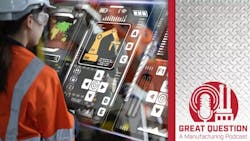Jerry Grunewald, Raj Polanki, Ryan Kuhlenbeck, and Greg Whitt recently spoke at IndustryWeek’s Operations Leadership Summit, which Smart Industry co-sponsored. This podcast is drawn from their panel conversation, “Modern Tools for a Modern Workforce.”
Grunewald, the VP of operations innovation at INVISTA who has occupied leadership positions in R&D and operations during his 35-year career, also managed INVISTA’s digital transformation efforts and is working to make the plant of the future a reality.
Polanki is the U.S. region head of IT for Wacker Chemical Corp. and has more than 20 years in IT leadership. His qualifications are voluminous, including an MBA, PMP, CISSP, CGEIT, CISA, CISP, ITIL, TOGAF, COBIT, SAFe, as well as SAP and Microsoft certifications.
Kuhlenbeck is the co-founder and CEO of Pico MES and has a history of working in automotive manufacturing at General Motors, Tesla, and Alta Motors, where he experienced firsthand the real-world issues created by the manufacturing digital divide.
Whitt is a process improvement engineer at MORryde, where he finds areas in which to gain additional value.
The four experts explored how to see benefits through addressing the intersection of people and technology. In this episode of Great Question: A Manufacturing Podcast, SI Managing Editor Scott Achelpohl shares the audience questions and expert answers from the session.
Below are excerpts from this podcast:
Jerry Grunewald: We've been talking all week about people, process, and technology. We absolutely agree with that, and we would say even more importantly, it's in that order. You need the people, lifelong learners, that have a contribution mindset. Changing the work itself, using the power of new technology. It's all about data and technology, that's certainly the why and the why now, but the people and the work processes are the how.
See also: N. American manufacturers drive 27% surge in AI adoption since 2022
Our approach has been four work streams leading digital transformation across our 13 global sites. We start with learning and development, and in that effort, we're really trying to ban the word training because if my job is the trainer and you're the trainee, the onus is on me for you to get trained.
Learning is not just semantics. It is a whole different mental model. The onus is on the learner, and the tools have to be different. You have to present, enable tools that people can learn in their own way on their own pace. So, in this particular work stream, we've been taking great advantage of digital twins.
We have asset digital twins, we have product digital twins, we have learning twins. We also have processed twins, and lately, in the last 12 months or so, we've been really driving Gen AI to those twins as a layer over top. So, the learner can use the generative AI and query the twin to give information back, and that's really been accelerating our learning. Our goal is to make people functional and capable in months, not years, because that's how you're going to be able to get to the workforce of the future.
See also: What’s the best way to bring AI into engineering?
Raj Polanki: Who will train? How can we make people learn these things? Is it one trainer who's helping thousands of people learn? That is not practically possible, and it's very time intensive. So, we're developing a new model called digital champions. I'm starting this program, which I got approval for last week only. The design of this program is to identify these champions in every team of the company. The team size may be five or the team size may be 50.
We identify a person who is technically savvy, technically enthusiastic, to learn and leverage, and then make them part of a community of practice. We share their learnings, and more importantly, we enable them with what's possible. It can be as simple as, do you know what the capabilities of SharePoint are and how much we are utilizing it today? What is Power Automate? What is Tableau? What are analytical tools and Generative AI?
See also: Episode 3 of (R)Evolutionizing Manufacturing: All About AI
So instead of trying to teach the entire team, we're trying to identify each person in each team and enable them. We want them to be the multipliers and representatives for their teams. So that way, I think our goal is to achieve this digital transformation from the bottom up. Again, going to digital workers, leveraging this multiplier effect, I'm hoping I'll be successful in that, but right now we're going to start as a volunteer base to assignment of individuals from the teams like “Hey, you need to dedicate at least four hours in a month to join this group and learn and contribute.” Once we have an ROI proven case there, we're going to make it mandatory for every team.
See also: Optimizing your OT/IT cybersecurity strategy for an Industry 4.0 world
Ryan Kuhlenbeck: Our biggest company is Fortune 100, our smallest company is 20 people, and we span the gamut in between. If you are an enterprise facility, think a billion or more a year in revenue, more multi-site, you are on a digital transformation journey for multiple years. You're focused on taking technology pilots and pushing them everywhere to get the value in a lot of ways, and then structuring everything to support it. Upper mid, so 500 million to that next enterprise level, these are like 4 sites maybe 10. Companies of that nature are the ones buying right now. These are the companies that have initiatives. The tech gap has crossed over on the business case, so they're actually, actively sorting, and the difference there is instead of maybe 30 technologies in the stack, the stack might have 5 to 6. You go a level down into SMB. The early adopters are present, but 80% and beyond have not done anything yet. They have an ERP, maybe. How well they use it is debatable, and are looking at what is the next thing, either bolting on more to it or figuring it out from there. And then tiny, 50 people or less inside of a facility, is still somewhat abandoned from an options perspective.
See also: Webinar: Tons of tips from three experts on ‘Being Digital’
So depending on which one of those you live in, the constraints might be data, change agents, or artificial intelligence. If you're hanging out in SMB, you don't really care about artificial intelligence. You’re trying to figure out how to print a serial number label. So what we see that's really interesting is what it took you to do in five years, the next one who starts today can probably do it in a year because there’s a path to follow. And then you can deviate on your own, so you don't have to pioneer the technologies and techniques that five years ago you were pioneering.
About the Podcast
Great Question: A Manufacturing Podcast offers news and information for the people who make, store, and move things and those who manage and maintain the facilities where that work gets done. Manufacturers from chemical producers to automakers to machine shops can listen for critical insights into the technologies, economic conditions, and best practices that can influence how to best run facilities to reach operational excellence.
About the Author
Scott Achelpohl
Head of Content
I've come to Smart Industry after stints in business-to-business journalism covering U.S. trucking and transportation for FleetOwner, a sister website and magazine of SI’s at Endeavor Business Media, and branches of the U.S. military for Navy League of the United States. I'm a graduate of the University of Kansas and the William Allen White School of Journalism with many years of media experience inside and outside B2B journalism. I'm a wordsmith by nature, and I edit Smart Industry and report and write all kinds of news and interactive media on the digital transformation of manufacturing.

